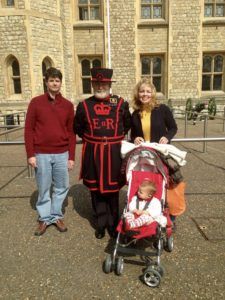
Today we visited the Tower of London, a fortress situated on the bank of the River Thames. I put a mental check mark on being able to visit another UNESCO World Heritage Site. It was founded in 1066 as part of the Norman Conquest of England. The White Tower was built by William the Conqueror in 1078 and was a symbol of oppression, used as a prison for centuries. The entire complex is comprised of several buildings set within two concentric rings of defensive walls as well as a moat. There were several phases of expansion under Kings Richard the Lionheart, Henry III, and Edward I in the 12th and 13th centuries. The Tower has been used as an armory, a treasury, (sadly) a menagerie, and home to both the Royal Mint as well as the Crown Jewels of England. We are pictured here standing next to our Yeoman Warder, or “Beefeater” who conducted our tour. These men have formed the Royal Bodyguard since at least 1509. More than ornamental tour guides, they are required to have served in the armed forces with an honorable record for at least 22 years. These men are military veterans who still guard the tower today around the clock. I believe I speak for all three of us when I say our favorite part of this visit was seeing the ravens. Legend says that the kingdom and the Tower will fall if the six resident ravens ever leave the fortress. We got to see the Raven Master feeding the seven large birds (six plus a spare) up close. It was a treat to be so very close to them without any barriers; they ate just a few feet from us on the lawn. I had seen plenty of crows but I did not fully realize how huge their brethren were. They reminded me a bit of vultures. The ravens preside over four different territories within the Tower precincts and the birds are officially enlisted as soldiers in the Army. There are records of some being dismissed from their ‘duties’ at the Tower for unsatisfactory conduct; one had a penchant for eating television aerials. Another kept escaping and visiting the zoo. The English philosopher John Locke said, “Fortitude is the guard and support of the other virtues.” I think that is a very apt description for our next stop, which was accidental, and proved to be the highlight of our trip. We stumbled upon a little church on a bustling street corner and decided to go in. All Hallows-by-the-Tower is an ancient Anglican church overlooking the Tower of London. Previously dedicated to St. Mary the Virgin and founded in 675, it is one of the oldest churches in London. Inside we discovered it contained a 7th century Anglo-Saxon arch with recycled Roman tiles — the oldest surviving piece of church fabric in the city. The church has a free museum; the Undercroft Museum, containing portions of a Roman pavement and many other artifacts discovered below the church in 1926. This sacred jewel was so much of what I loved all in one: history, Christianity, AND it was the ONE CHURCH IN ALL OF LONDON we discovered that allowed pictures! God bless them. So it was there, in this ancient church, that I found my joy. I knelt to pray on the exquisitely embroidered kneelers and gave thanks for the gracious welcome we received there and for the respite from the city. Narrowly escaping the Great Fire of 1666 and surviving extensive bombing by the Germans in World War II, its 1300 years of faith shows fortitude that guards virtues surpassing that of the Tower.

It’s so wonderful that you are documenting all these wonderful trips & things you saw & did !
It wil be worth everything in the years to come!
Thanks Fay! I’m four years behind so I’m trying to catch up before I forget!